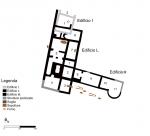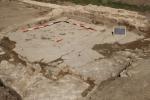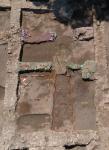Summary (English)
Trench CXI (building M)
In the easternmost part of the excavations (Trench CXI) work continued on the building formed by rooms 8-11, whose first phase dates to between the 2nd and 3rd centuries A.D.
The excavations in room 10 extended over a surface area of 4.28 × 4.35 m where a late antique occupation phase was identified, which the materials, found within a loose foundation of broken tiles, date to between the late 6th-early 7th century A.D. (Fig. 2).Between the 3rd and 4th centuries A.D., the room had a tile floor boded with mortar, which however was not part of the original structure. The latter dated to the Severan period and had a floor of white and bluish-grey crustae, largely robbed at the moment when the floor level in the room was raised. The marble slabs forming the skirting were still in situ in correspondence with the inner faces on the north, west, and south walls, and were partially covered by the tile floor.
To the east of room 10 a large opening led into a second room (room 11), that was a pre-existing structure. Although only a limited part of the latter was investigated, it was seen to have a marble floor similar to that in the adjacent room. In a phase that remains to be defined, but post dates the early 3rd century A.D., a wide apse (c. 7 m) was built into the south wall of room 11, which emphasised its function, together with room 10, as a reception area (Fig. 3).
Trench CXII (building L)
In the central-western sector (trench CXII), the excavations concentrated on room 5 of building L. A series of actions dating to about the beginning of the 3rd century A.D. were identified, which altered the room’s plan – divided in two in the first phase (Flavian period) – and which are probably linked to alterations and/or a change in the building’s function (Fig. 4). Moreover, these actions cut the stratigraphy relating to the pre-Roman occupation of the site (Fig. 5). Numerous fragments of medium and large containers with cordon decoration, probably a local production, were recovered that presented clear traces of a long exposure to fire, and bars of refractory clay used as supports in hearths typical of settlements producing salt. The stratigraphic excavations have therefore shown that room L overlay a site datable to the Bronze-early Iron Age, in which the inhabitants produced salt by boiling salt water.Resti di un insediamento protostorico sulle dune di San Gaetano, al di sotto degli horrea, già erano stati individuati negli anni ’90, costituiti da pali ed intonaco da capanna e vasellame. I dati della campagna 2018 arricchiscono dunque il quadro dei paesaggi di età protostorica.
In the 1990s, the remains of a proto-historic settlement were found on the dunes of San Gaetano below the horrea. The remains consisted of post and plaster from huts and pottery. The evidence from the 2018 excavations thus adds to the picture of the proto-historical landscape.
- S. Genovesi-Università di Pisa Dipartimento di Civiltà e Forme del Sapere
- F. Bulzomì- Università di Pisa Dipartimento di Civiltà e Forme del Sapere
Director
- P. Sangriso-Università di Pisa Dipartimento di Civiltà e Forme del Sapere
Team
- F. Bulzomì- Università di Pisa Dipartimento di Civiltà e Forme del Sapere
- S. Genovesi-Università di Pisa Dipartimento di Civiltà e Forme del Sapere
Research Body
- Università di Pisa Dipartimento di Civiltà e Forme del Sapere
Funding Body
- Ineos Manufacturing Italia S.P.A.
- Inovyn Company
- Università di Pisa






![Download [PDF]](/excavation/skins/fasti/images/results/download_sml.png)


